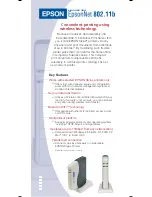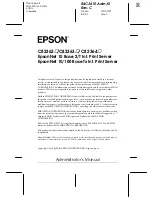
Overview
1-13
1
•
LU pool
- Allows you to maximize access to the host system. A client does
not depend on a system or a connection to access the host system, but can
connect to a dependent LU as long as the LU is available from the pool.
•
PU
- Allows you to provide several resources for the client connection. If a
particular dependent LU is unavailable or in use, the client can connect to
another LU under the PU. In addition, multiple users from a node can
access the host system.
Note –
If you use a PU as the default resource and a system outage occurs,
local area users may not have host connections since the PU is not available.
Note –
If you use multiple default resources, Sun recommends that you do not
specify a PU in the list.
For an LUType 2 client, if you do not specify a default resource or if none of
the default resources exist, and if the client does not specify a resource, the
server connects the client to the LU pool PUBLIC. For an LUType 0, LUType 1,
LUType 3, or LUType 6.2 client, if you do not specify a default resource or if
none of the default resources exist, and if the client does not specify a resource,
the software returns an error.
Note that you can also specify the users or user groups that can access a
resource (dependent LU or LU pool) in the configuration of the resource. This
allows you to make changes to a user record without modifying the resource.
Note that if no users or user groups are specified for a resource, any client can
access the resource.
User records also allow you to specify which resources system/network
administrators can configure and control. By default, all system/network
administrators are master operators. As a master operator, you can modify the
configuration of the server or change the status of resources without
restriction. You can also create user records to restrict the access of other
system/network administrators to a particular portion of the active
configuration, enabling you to establish independent operator domains.
Note –
You can add, modify, or delete users at any time without affecting
existing sessions.
Содержание SunLink SNA 9.1 PU2.1
Страница 14: ...xiv SunLink SNA 9 1 PU2 1 Server Configuration Guide August 1997...
Страница 16: ...xvi SunLink SNA 9 1 PU2 1 Server Configuration Guide August 1997...
Страница 18: ...xviii SunLink SNA 9 1 PU2 1 Server Configuration Guide August 1997...
Страница 26: ...xxvi SunLink SNA 9 1 PU2 1 Server Configuration Guide August 1997...
Страница 48: ...1 22 SunLink SNA 9 1 PU2 1 Server Configuration Guide August 1997 1...
Страница 66: ...2 18 SunLink SNA 9 1 PU2 1 Server Configuration Guide August 1997 2...
Страница 80: ...3 14 SunLink SNA 9 1 PU2 1 Server Configuration Guide August 1997 3...
Страница 110: ...6 12 SunLink SNA 9 1 PU2 1 Server Configuration Guide August 1997 6...
Страница 120: ...7 10 SunLink SNA 9 1 PU2 1 Server Configuration Guide August 1997 7...
Страница 132: ...8 12 SunLink SNA 9 1 PU2 1 Server Configuration Guide August 1997 8...
Страница 226: ...A 10 SunLink SNA 9 1 PU2 1 Server Configuration Guide August 1997 A...
Страница 282: ...F 16 SunLink SNA 9 1 PU2 1 Server Configuration Guide August 1997 F...
Страница 288: ...G 6 SunLink SNA 9 1 PU2 1 Server Configuration Guide August 1997 G...
















































